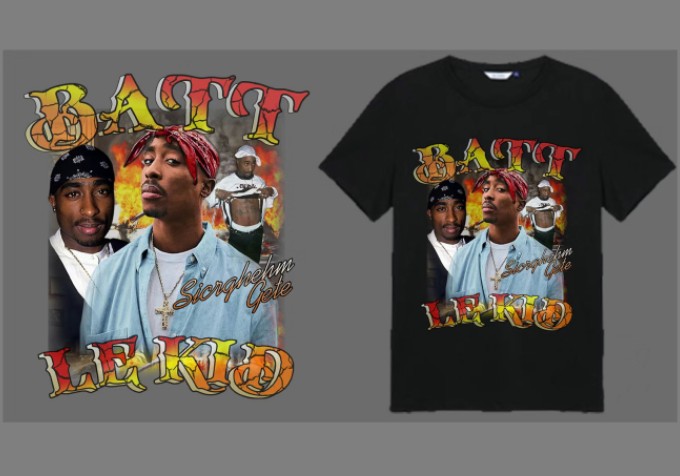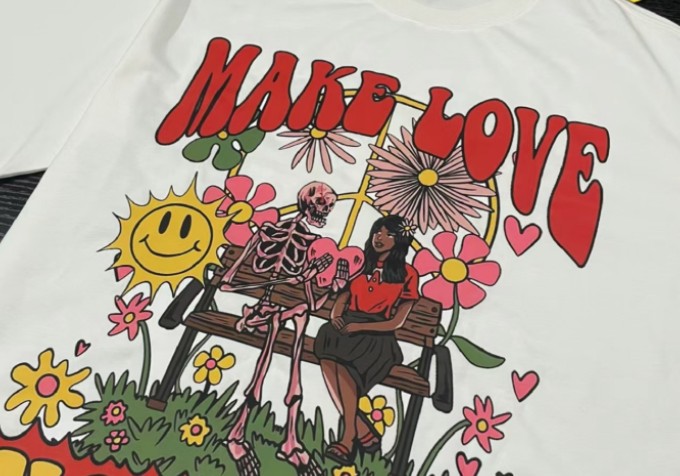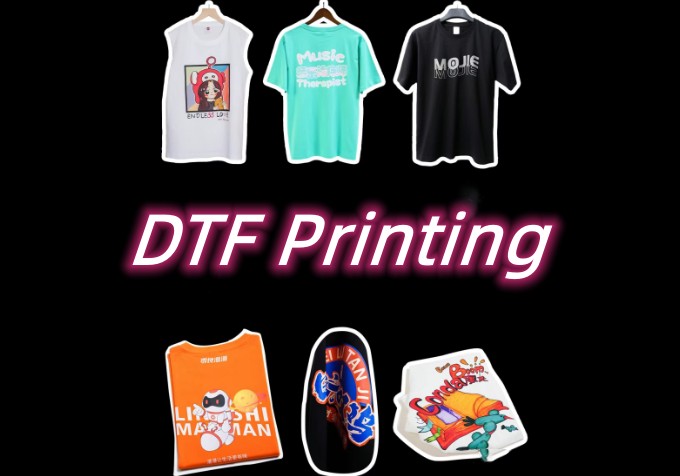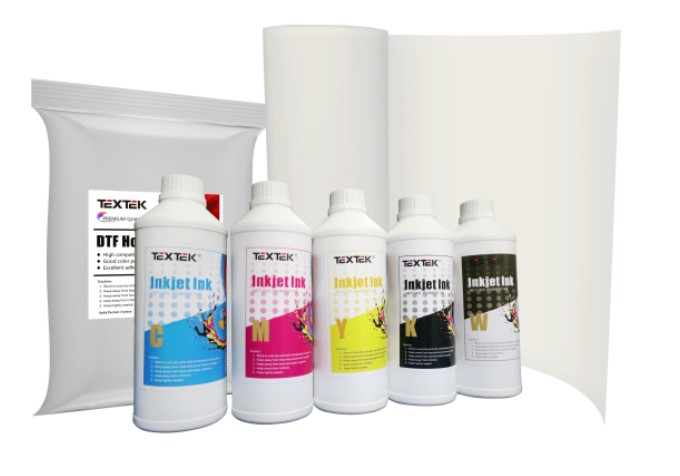22
Sep
Personalizing clothing has long been the job of heat transfer vinyl (HTV); tried, tested and trusted by many printing businesses and their customers. However, direct-to-film (DTF) transfer technology has exploded in popularity, becoming a real solution for custom fabrics and beyond.
DTF and HTV each have advantages that make them more suitable for certain situations. In this article, we'll explain the advantages and compare the two technologies to help you decide which option is right for your next printing business.

What is DTF Printing?
DTF printing is the process of using a heat press to transfer inks from a special transfer film onto a substrate. The hot melt powder on the film acts as an adhesive, and once cooled down to room temperature; you can peel off the film.
DTF printing is notably versatile; for example, you can print designs onto cotton, polyester, and metal. With DTF printing, you have the freedom to create a customize an array of products, as the prints are also durable without risk of cracking or stretching. If well taken care of, a DFT print can last for an extended period of time.
The DTF printing technology process usually includes the following steps: design, print on film, apply adhesive powder, cure, trim, heat press, remove the film, and finish.
How DTF printing works?
DTF printing works through the use of high-quality adhesives to fasten the print to a garment.
Most DTF printers use a powder-based adhesive. This adhesive actually lets print shops determine the hand feel of their DTF prints. For instance, a shop can choose to use glossy, matte, or even soft-hand adhesives for different applications and softer shirts.
DTF prints can be applied to almost anything that can withstand the heat and pressure required to apply the print.
What is HTV?
Heat Transfer Vinyl, or HTV for short, is a speciality polyurethane with a heat-activated adhesive (typically polyester-based) that can be used on certain fabrics and materials to apply designs to promotional products, textiles and apparel, such as T-shirts. It comes laminated together with a clear polyester carrier in a roll or sheet form, with an adhesive tacky backing, so it can be cut, weeded, and placed on a substrate for application via a heat press. The design is cut into the material with a cutting plotter in reverse (adhesive/vinyl side up). The excess material is removed with tools such as hooks or tweezers - a manual and facile process referred to as "weeding". The tacky adhesive between the carrier and the vinyl holds together complex designs, although the labor naturally increases the more weeding that is required. The clear polyester carrier keeps the design visible to aid positioning on the substrate. For these and other reasons, it is a popular and more robust alternative to transfer paper (that does not incorporate a carrier sheet). Heat transfer vinyl is made in single colors and also has special options such as patterned, glitter, flocked, holographic, glow-in-the-dark, reflective and 3D puff. Heat transfer vinyl also benefits from a high degree of stretch and rebound, achieved by a memory effect, making it suitable for use on apparel and other flexible items including the garments typically used, such as sports jerseys.
How does HTV work?
This type of vinyl can be bought in single pre-cut sheets or rolls of various sizes. This means that you can easily buy large or small quantities to suit your needs without worrying about waste.
Each vinyl sheet or roll consists of a shiny top layer called the carrier, the actual vinyl and an adhesive backing.
The carrier is typically a clear, polyester backing, and it is what keeps the vinyl fixed in place during the cutting and application process. Some are sticky, and others are not, so it’s important to pay attention to this when you’re choosing a vinyl. This sheet should remain intact during the cutting process so that it can be peeled off easily.
The adhesive backing is what secures the vinyl to the fabric, and it is what receives the cuts when you are printing a design.

Why is DTF(direct to fabric) better than HTV(heat transfer vinyl)?
Production Speed
Production speed is where DTF printing shines compared to HTV. It might be true that HTV does require fewer expenses to start printing, but the time-consuming process of weeding can affect the production time needed. In DTF’s case, the printer will create your design, and you can immediately take it to the heat press and apply it to the garment with no weeding required.
DTF printing simplifies the process by customizing your design software and printer settings. Once everything is set up to your liking and calibrated to the needed settings, you can start printing multiple designs on multiple sheets of transfer film. Larger printers can save time and cost by printing multiple designs on a long, wide roll of transfer film. With proper quality control, you can easily have a batch of garments ready for shipping.
Simple HTV designs can reduce the time needed to weed excess materials. Still, you can’t repeat the same process for a large batch of prints, not unless you have a good amount of staff available who can help speed up the process. Even then, a tiny mistake in weeding can result in a wasted vinyl sheet. The precision needed ultimately becomes a detriment, which is why HTV is not ideal for bulk orders.
Versatility
DTF prints are also extremely versatile and can be printed on nearly any fabric, including but not limited to cotton, Cotton blends, polyester, rayon, and silk. Before printing on your chosen fabric with a DTF printer, you must configure your heat press temperature and pressure settings to prevent ruining the garment or causing burns. With DTF printers, you can print onto ceramics and even metallic surfaces–the options are endless! It’s easy to transfer designs regardless of the shape of the surface. You only need a heat press to apply prints to mugs and other items.
Not to mention, if you have extra prints, you can always sell them individually. If any of your customers want the print job done for themselves, they can buy the excess prints from you. You should keep these stored in a safe place (far from dust and other materials that could ruin them), like a drawer or cabinet, so they’re easy to access when needed.
Affordable
DTF printing is more affordable than traditional methods like screen printing, vinyl cutting, and direct-to-garment (DTG) printing. The initial investment for a DTF printer is lower because you don’t need to purchase any screens or other materials. You also don’t need to worry about the cost of darkroom chemicals for developing screens.
DTF printers are also more affordable to operate than other types of printers. For example, a DTF printer uses less ink than a DTG printer, and the film is cheaper than vinyl. Additionally, there are no set-up or screen-printing fees associated with DTF printing.
Also, you could buy two DTF ink bottles for the price of a single DTG ink bottle. You can also find competitively priced transfer films and hot melt powder that have different properties depending on the printing application.

Print Quality and Durability
It might be tricky to tell the difference between an HTV print and a DTF one for the unenlightened. Both have a slightly plastic-like texture when you run your hand over the print. Still, HTV’s one is more prominent owing to how it was made; DTF prints are made from water-based CMYK inks that are somewhat similar to DTG inks.
When using a heat press to apply the DTF print to the garment, the heat and temperature generated from the heat press drive the inks from the film and onto the garment’s surface. A second heat press is recommended to ensure that the inks are driven into the garment’s fibers, helping to strengthen its durability and wash fastness.
The result is a decently soft hand that will last a long time; it won’t easily crack or stretch, especially after a second press. Factors such as the amount of ink or hot melt powder applied can also influence the overall print quality of DTF prints. Not all hot melt powders are created equal; some types may have different characteristics that affect the feel of the print.
With HTV, all you need to do is heat press the vinyl to the substrate, peel the carrier (whether it’s a hot, warm, or cold peel), and place the substrate elsewhere to cool. There’s no need for a second press; excess heat can damage the vinyl, causing the adhesive to weaken, and the print is likely to peel off.
In fact, your primary concern with HTV stems from the vinyl’s likelihood of peeling off or flaking over time. While it’s durable and fade-resistant on its own, the vinyl is “sitting” on the substrate’s surface, unlike DTF prints, where the ink has been “pushed” into the fibers on the substrate’s surface.

You want to start using dtf, what else do you need?
Hot melt powder
You'll want to apply the hot melt powder to your design while the ink is still wet. The powder melts and turns into a sticky adhesive, which then allows your design to stick to the adhesive side of the garment. Various factors, such as the amount of powder used, its general characteristics (e.g., white or black), and even climate, can affect the overall feel/appearance of a print.
DTF PET Film
This is a clear film that the design is printed onto. Once the design is printed, the transfer film is used to heat-press the design onto the substrate.
DTF ink
DTF printing uses digital water-based inks, which are very similar to DTG inks, but with some pigment adjustments. DTF relies primarily on white ink and standard CMYK colors, rather than using a wider color gamut. There are also friends who use fluorescent printing solutions and need fluorescent inks.
Heat Presses
A heat press machine is used to apply pressure and heat to the design, which helps to bond it to the substrate. You can use a standard iron, but a heat press will give you more consistent results.
TEXTEK can provide these for you!!!
Conclusion
To sum it up, DTF printing technology is better than HTV in terms of consumable costs, labor, and production efficiency. The two printing technologies are often compared, but the main difference is in their workflow processes. DTF has a more efficient and streamlined production process without the need for weeding. This means that time and labor can be better used for other purposes.
TEXTEK DTF printers (direct to film printers) work on all fabrics and are perfect for custom garment printing. You can expand your inventory by applying your designs to various items via DTF. With the advancement of DTF technology, it is undeniable that DTF is taking the printing industry by storm. It is quickly becoming one of the most popular technologies for textile printing compared to traditional printing methods.
TEXTEK's business covers many countries around the world, including emerging markets and mature markets. We have a complete sales system and are committed to using our professional knowledge and first-class service to help customers improve their digital printing business.
.jpg)
